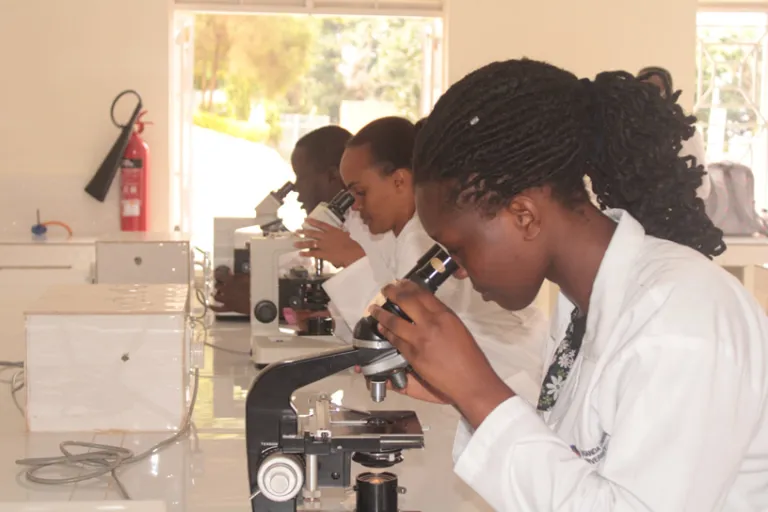Story By Patty Huston-Holm with Photos and Podcast by Vanessa Kyalimpa
Within five minutes of the first time that Vanessa Kyalimpa and I met Dr. Gerald Tumusiime, he was casually lifting and touching cleaned bones extracted from donated cadavers. Vanessa, a student in the Uganda Christian University (UCU) School of Journalism, Media and Communication, captured photographs while I took notes.
I wondered why this rubber-gloved dean for the UCU School of Medicine (SoM) was so attentive to the skeletal part of the human body.

Later, I got my answer. I discovered Dr. Tumusiime’s two bone-related pieces of research – both within the last year and concentrated on femur (thigh) bones of East African men. In brief and not doing justice to the studies by the esteemed doctor, senior lecturer and dean, I summarized his research on the 333 African men were about:
- External opening of femur bones to make a correlation between whether the opening that enables blood flow necessary for healing after surgery is inherited or acquired (International Journal of Anatomy and Research, India); and
- Size and shape of femur bones as this relates to assessing fracture risk and stability of hip joints and design of implants for hip replacement (Austin, Texas, Journal of Anatomy).
Whether serving in his role as researcher, teacher or practicing doctor, Dr. Tumusiime epitomizes excellence in the field of medicine. His passion for lifelong learning and elevating UCU SoM student knowledge and skill were clear on April 5, 2022, as he showed us around with a focus on how equipment informs evidence-based patient care. Much of what we saw in three different buildings, including where the UCU School of Dentistry (SoD) is housed, was donated a year ago by MedShare and Midmark through the non-profit Uganda Partners organization.
“Biomedical equipment promotes holistic and evidence-based patient care,” Dr. Tumusiime said. “While we teach that patient history and physical exams contribute over 80% to an accurate diagnostic, the equipment donated through the United States in 2021 is extremely valuable in shaping our future doctors into evidence-based, health care practitioners.”

The donated equipment and consumables contributed to the accreditation and licensure of UCU’s SoM and SoD by the Ugandan regulators, as well as the continuity of teaching and learning during the peak of the Covid-19 pandemic. The equipment boosted the schools’ ability to be accredited by the Uganda National Council for Higher Education. Such tools supplement learning in the UCU biomedical laboratories in gross anatomy, biochemistry, physiology, pharmacology, histology and microbiology and immunology.
The UCU equipment for the SoM, mostly donated in the past two years, and brief descriptions include:
- Microscopes (providing the “Gold standard” for tissue diagnosis) – Magnify what the human eye can’t see, such as cells indicating diseases, such as sickle cell
- Centrifuge – Separate, purify and isolate cells, proteins and viruses for further observation
- Vortex mixer – Combine vials of liquid to study enzymes and DNA
- Incubator – Maintain temperature, humidity and gas content to grow or maintain cells
- Bunsen burner – Used for heating samples and sterilization
- Safety cabinets – Protect researchers and others from potentially infectious materials
- Medical waste bins – Add safety from biomedical waste and sharp instruments
- Medical refrigerator and freezer – Protect and extend shelf life of bio-specimens, reagents, drugs and vaccines
- Protective gear (aprons, face masks, face shields, goggles, gloves) – Support safety in teaching and learning, research and patient care
- Assorted clinical diagnostic equipment – Promote the quality of patient diagnosis and research
The SoM Dean expressed appreciation for the donations that, despite a year of Covid-related distance learning, have boosted the holistic, evidence-based capabilities of UCU’s 230 students in the SoM and SoD as each completes a five-year program.
“There are many examples of how technology equips us to improve Uganda’s health care,” Dr. Tumusiime said. “For instance, in dealing with malnutrition among children, we are able to help by analyzing blood samples to guide nutritional interventions and monitor progress. In all age groups, we screen and diagnose non-communicable diseases like sickle cell anaemia, cardiovascular diseases, cancers and metabolic disorders that are currently on the rise in Africa.”
Dr. Tumusiime said that the need for more laboratory tools is ongoing, and singled out the equipment that is urgently needed to enhance teaching and learning, research and community service. In 2022, these necessities and their roles are:
- Biological teaching microscope – Enables the instructor to demonstrate to the learners in real time
- Hematology analyzers – Allow study of blood disorders and expanded understanding of human immune response
- Chemistry analyzers – Enable testing of 100 different components, including urine for detection of various infections, kidney disease and diabetes
- Blood gas/electrolyte analyzer – Measure blood sample parameters, such as oxygen concentration
“I appreciate that in a resource-limited setting, some of these equipment may not be readily available,” he said. “But it’s critical to the profession that they know they exist and know how to use them.”


